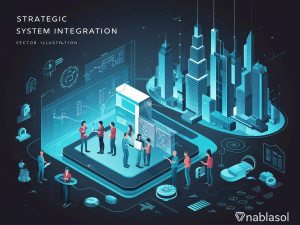Businesses are becoming more and more dependent on a wide range of software platforms and apps in today’s fast-paced digital environment to optimize operations. This is when system integration becomes an essential theory. Integrating many systems, including databases, software programs, and IT infrastructures, to work as a unified entity and facilitate communication and data flow throughout the company.
When Is System Integration Necessary?
The process of integrating multiple independent systems—each created for a distinct function—so they can function as a cohesive one is known as system integration. Improving decision-making, decreasing data silos, and increasing operational efficiency all depend on this integration. For businesses experiencing digital transformation or trying to get the most out of their IT expenditures, it’s especially important.
Different Types
Vertical Integration: Joining subsystems based on how they complete a specific task.
Horizontal integration: It is the process of connecting several systems using a single interface layer, often known as an integration platform.
Star integration: Sometimes referred to as spaghetti integration, is the process of connecting every system to every other system directly.
Methods of System Integration
Point-to-Point Integration: Direct connections between systems are usually employed for straightforward integrations.
Middleware integration: It is the process of enhancing system engagement by using an intermediary layer, like an API integration platform.
Enterprise Service Bus (ESB): An advanced method for managing integrations using a central hub.
Techniques for Linking Systems
There are several ways to integrate systems, including web services, APIs, and integration tools. To improve financial visibility and management, for example, Sage Intacct connectors can be integrated with other business applications using APIs.

Advantages of Integrating Systems
Enhanced Efficiency: Minimizes manual labor and automates procedures.
Improved Data Accuracy: Reduces errors by guaranteeing that data is consistent amongst systems.
Improved Decision-Making: Offers a comprehensive perspective of corporate activities, supporting well-informed choices.
Scalability: Makes it easier to add new components without affecting current functionality.
Challenges with Systems Integration
Complexity: Combining several systems can be a complex task that calls for specialized knowledge.
Compatibility Issues: It can be difficult to guarantee that several systems can interact with one another efficiently.
Security Concerns: It’s critical to safeguard data throughout the integration process.
Procedures for Implementing
Evaluation: Examine the current systems and specify the integration needs.
Planning: Create a plan outlining the technology, tools, and integration strategy that will be applied.
Development: To create the integration solution, apply software development techniques like agile development.
Testing: Verify that the integrated system fulfills the predetermined requirements and operates as anticipated.
Conclusion
Businesses need system integration because it links all enterprise apps and makes it easier for customer data to move. It is necessary for internal cooperation inside an organization as well as B2B interactions. It is possible to guarantee smooth operations by integrating obsolete but vital legacy systems with contemporary solutions via communication channels. Additionally, by facilitating real-time data interaction across several departments, integrating multiple business apps into one ecosystem improves efficiency. Furthermore, one common way that B2B enterprises improve their products is by using API-based interfaces to extend the functionality of already existing systems.
Following a few basic practices can ensure a smooth data conversion process into a CRM system. These include drafting a plan for data migration, ensuring data accuracy through cleaning, testing before migration, and validating data after migration. Data backups must be made before migration, and once the entire process is complete, it must be verified that everything has moved correctly. For CRM data migration to be successful, migration waves must be carefully planned based on the significance and interconnectedness of data inputs. An effective CRM migration project depends on selecting the appropriate data migration strategy,



